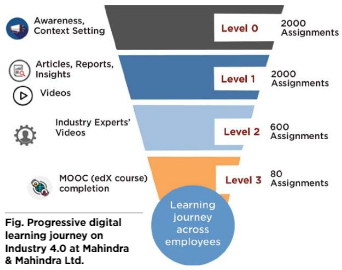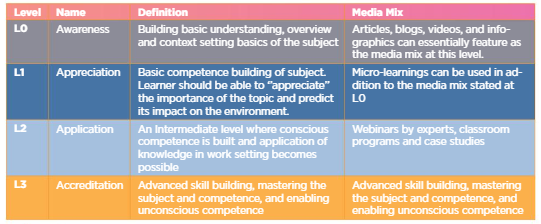The 4A way of learning: A practical approach to organizational learning goals

Although organizational lenses for learning and development have evolved considerably over the last few decades, the underlying concept of learning taxonomies still prevails.
Learning taxonomies allow the definition of learning behaviors. Traditionally and even today, L&D professionals and organizations use learning taxonomies to distinguish different levels of human cognition, such as remembering, thinking, understanding, or applying. Taxonomies thus play a critical role to create layers or degrees of learning. Out of the many learning taxonomies, organizations have most often preferred Bloom’s taxonomy, which identifies three distinct skill domains—cognitive, affective, and sensory—and breaks each domain down into levels of learning objectives. This fundamental approach of classifying learning items with the same objectives, and explicitly indicating what a learner must do to demonstrate learning, is why Bloom’s taxonomy has been so often adopted as a foundational framework for setting up an organization's learning goals.
Applying Bloom's taxonomy to create a practical model
With our decades of experience in learning delivery, keeping the learner at the central focus, we believe it is critical to translate the philosophy into a practical model that serves well in today’s organizational context. First, however, we must understand and address the challenges.
Bloom’s taxonomy was developed in the 1950s and although it has seen an evolution in the intervening years, its 2001 revision still presents a few fundamental challenges in the real-world context for any organization. The first challenge that has been generally observed, is that while the lowest three levels of Bloom’s taxonomy—Knowledge, Comprehension, and Application—have a hierarchical order, the three higher levels are more parallel. The distinction between Create, Evaluate, and Analyze in a learner’s assimilation of knowledge is subject to debate. Also, in real-world problem-based learning, it could be sometimes more logical to move to the application before concepts, introducing the real-world context to make it relatable before the theoretical wisdom.
The second challenge, and perhaps the most testing, is the clean-cut distinction of different levels that Bloom’s proposes. The clear distinction and level, while well defined, may not be considered an accurate representation of the way learning takes place. Humans may not necessarily go in the order of remembering things, to understanding, then applying and so forth unto creating. Bloom’s taxonomy levels hence miss the interrelated and overlapping nature of cognition.
Bringing these challenges into consideration, learning across levels and its cognitive interconnectedness can be approached by visualizing the learning framework. Blending the traditional layers into ‘Learning Levels’, this approach can be envisaged more practically in today’s context and further leveraged toward creating learning curriculum and interventions.
Level-based approach: The 4A Way of Learning
The 4A Way of Learning as an approach covers four different thematic levels towards learning, each level denoting the depth of the competence building and guiding the design attributes. This approach retains Bloom’s level-wise approach to learning while cutting across layers to define 4 ‘A’s of learning delivery. In addition, the approach also proposes correlating media mixes that blend with the four levels of learning.

With the 4A approach, Bloom’s taxonomy translates into an array of micro learning content that enables practitioners to create and develop digital programs that are business specific and learner-centric. The practical and flexible aspects allow a practitioner to deliver any training solution by applying the 4A backbone and implement contextual programs.
An illustrative example: The future skills domain
An exemplary application in the future skill domain of Industry 4.0 has been successfully implemented and deployed at Mahindra & Mahindra Ltd., for a learner population of approximately 2,000 Manufacturing employees. In this application, the 4A approach is a step-by-step built up training program that filters the learner group at every step, based on the degree of knowledge deployment required.

The progressive approach of the digital learning journey allows multiple learning paths and levels of learning within one holistic journey, also allowing practitioners to further sharpen a homogeneous employee base into targeted employee group needs. In the digital space, it also allows the program developers to provide a plethora of mixed digital media solutions addressing each level of the 4A approach.

A critical aspect for an in-depth examination of the approach is to consider the cost-time investment versus impact. When investing in the curation of digital learning programs, the simplistic nature of the approach allows a high impact delivery while maintaining the cost-time investment in the development of one holistic program, and differentiation in its deployment. The impact can be staggered across different learner groups, allowing learners to adopt and upskill in phases.
The business impact: Deep skilling
In today’s age of evolving business dynamics, skill development is observed through multiple lenses. Organizations are re-looking at existing skills, consciously identifying critical impact areas for future-readiness, and maintaining a competitive edge. As one deep dive into specific areas of future skilling, a robust method to develop continuous learning paths ultimately deep skilling needs to be the end goal.
The 4A Way of learning allows for the progressive nature of developing skills each level at a time. In a phase-wise manner, upskilling patterns lead to continuous progress of learning. This can be clearly observed in the Industry 4.0 example illustrated above.
Application in the virtual scenario
The 4A Way of Learning proposes a compelling approach for driving digital L&D interventions across an organization, especially given the virtual working environment. As a tested model with visible success stories, it has immense potential in the new digital age of our businesses where remote working is the new reality. With the evident rise of L&D in the virtual space, the model enables spanning this approach towards deploying 4A-based training programs to global partners across the world.
This constructive alignment and correlation to Bloom’s taxonomy ensure the fundamental principles of learning are retained even while we observe a shift from traditional classroom programs to online learning. The importance of this balance is predominant in nurturing the mindset shift for all practitioners to adopt online learning methods to deliver training solutions.
















